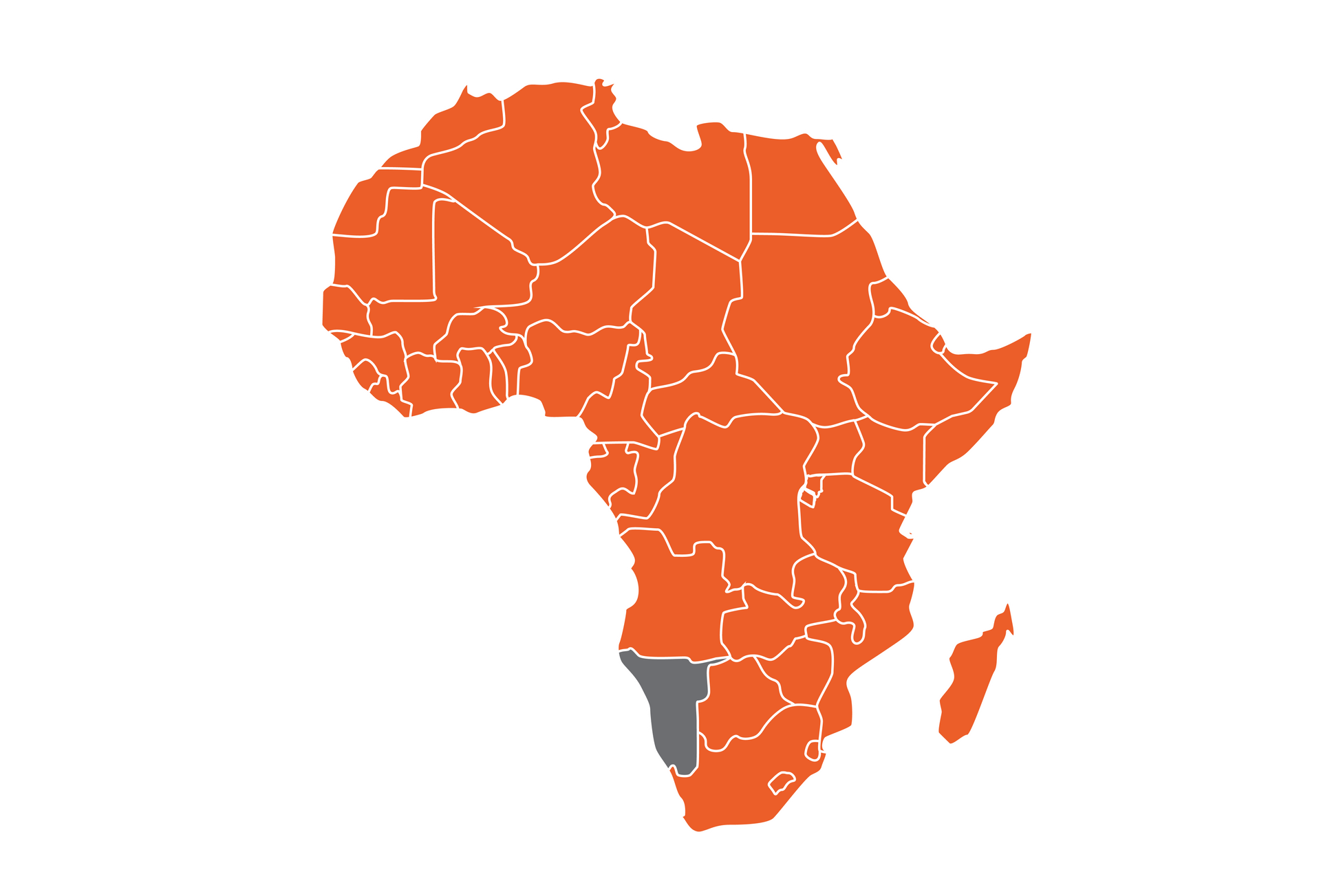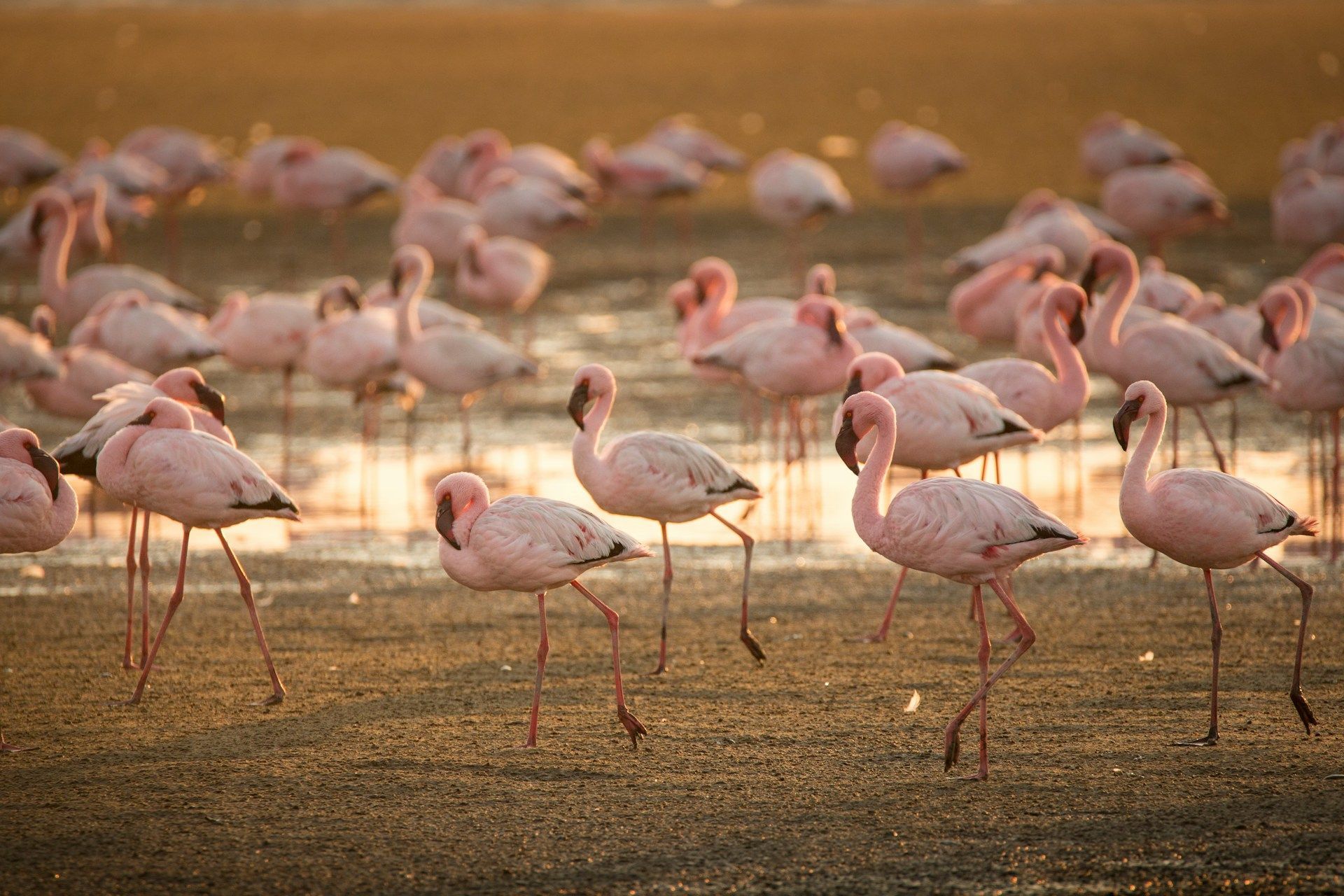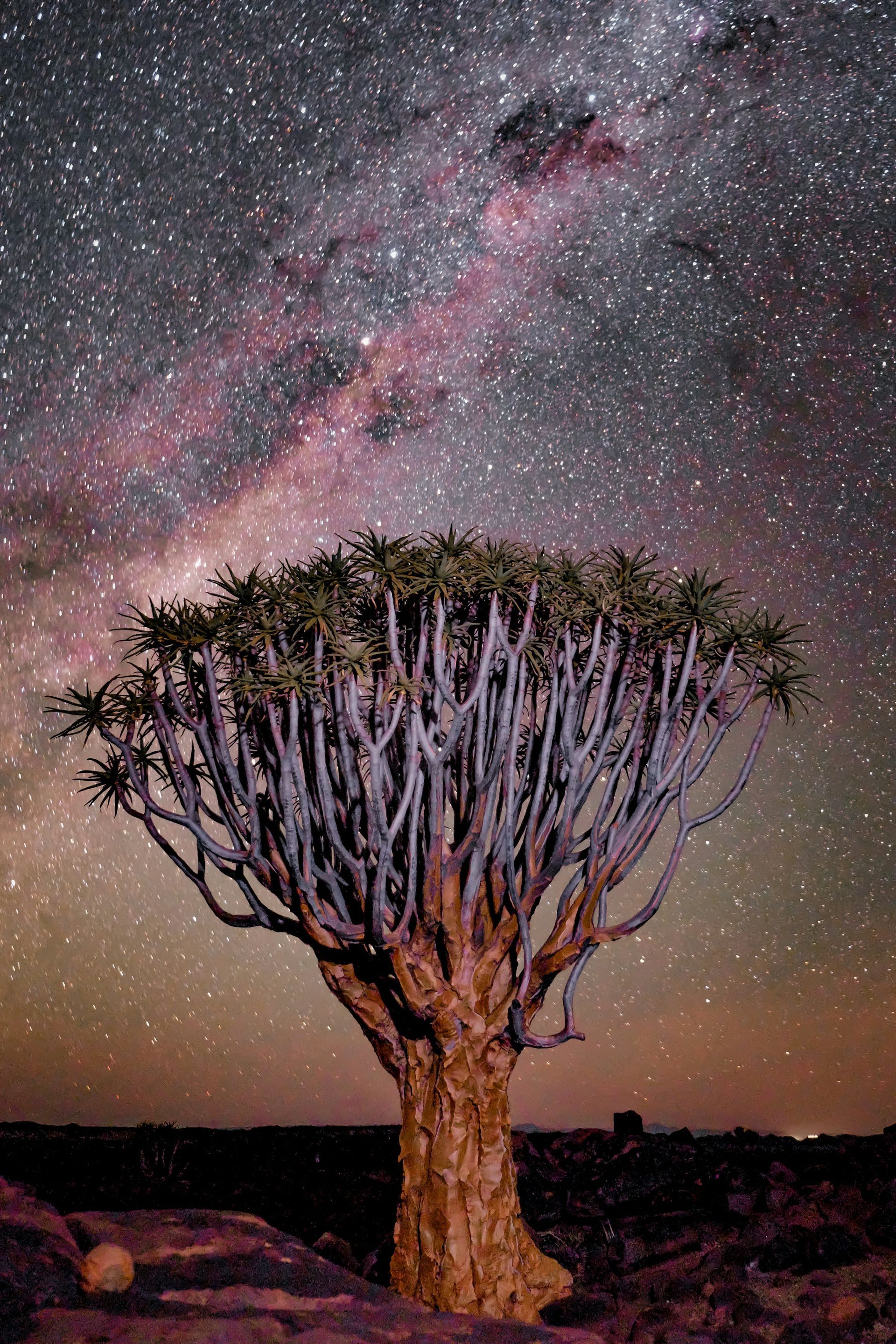Namibia
Namibia
Namibia
Ancient wonders and endless horizons
Namibia isn’t just a place you visit. You experience it.
You feel the wind shaping the dunes of the Namib Desert, hear the silence of the Skeleton Coast, and see the sun set over the red sand stretching endlessly. You watch desert-adapted elephants move quietly across the plains, and you stand still as the stars blaze bright in the clear night sky.
At Ubon Safari, we offer more than just luxury safaris – we craft journeys that connect you deeply to Namibia’s wild heart. We know the land intimately, and we’re here to share its vast landscapes, rare wildlife, and timeless beauty with you in a way that’s immersive, authentic and unforgettable.

Ancient wonders and endless horizons
Namibia isn’t just a place you visit. You experience it.
You feel the wind shaping the dunes of the Namib Desert, hear the silence of the Skeleton Coast, and see the sun set over the red sand stretching endlessly. You watch desert-adapted elephants move quietly across the plains, and you stand still as the stars blaze bright in the clear night sky.
At Ubon Safari, we offer more than just luxury safaris – we craft journeys that connect you deeply to Namibia’s wild heart. We know the land intimately, and we’re here to share its vast landscapes, rare wildlife, and timeless beauty with you in a way that’s immersive, authentic and unforgettable.
Ancient wonders and endless horizons
Namibia isn’t just a place you visit. You experience it.
You feel the wind shaping the dunes of the Namib Desert, hear the silence of the Skeleton Coast, and see the sun set over the red sand stretching endlessly. You watch desert-adapted elephants move quietly across the plains, and you stand still as the stars blaze bright in the clear night sky.
At Ubon Safari, we offer more than just luxury safaris – we craft journeys that connect you deeply to Namibia’s wild heart. We know the land intimately, and we’re here to share its vast landscapes, rare wildlife, and timeless beauty with you in a way that’s immersive, authentic and unforgettable.
Why Namibia will stay with you
Namibia is a land of extremes and contrasts. It’s where desert meets sea, where rugged mountains frame sweeping plains, and where wildlife has adapted to survive in some of the harshest environments on Earth.
Here, landscapes are vast and crowds are rare. You might spend a whole day watching gemsbok traverse the sand under wide skies with nothing but silence around you. Namibia invites you to slow down, to listen, to breathe, and to connect with a wilderness that feels both ancient and alive.
At night, the sky is a spectacle like no other – millions of stars shining with clarity that makes the bush come alive in a different way. Whether you visit in the dry season or the rare rains, Namibia’s magic is constant.

Why Namibia will stay with you
Namibia is a land of extremes and contrasts. It’s where desert meets sea, where rugged mountains frame sweeping plains, and where wildlife has adapted to survive in some of the harshest environments on Earth.
Here, landscapes are vast and crowds are rare. You might spend a whole day watching gemsbok traverse the sand under wide skies with nothing but silence around you. Namibia invites you to slow down, to listen, to breathe, and to connect with a wilderness that feels both ancient and alive.
At night, the sky is a spectacle like no other – millions of stars shining with clarity that makes the bush come alive in a different way. Whether you visit in the dry season or the rare rains, Namibia’s magic is constant.

Why Namibia will stay with you
Namibia is a land of extremes and contrasts. It’s where desert meets sea, where rugged mountains frame sweeping plains, and where wildlife has adapted to survive in some of the harshest environments on Earth.
Here, landscapes are vast and crowds are rare. You might spend a whole day watching gemsbok traverse the sand under wide skies with nothing but silence around you. Namibia invites you to slow down, to listen, to breathe, and to connect with a wilderness that feels both ancient and alive.
At night, the sky is a spectacle like no other – millions of stars shining with clarity that makes the bush come alive in a different way. Whether you visit in the dry season or the rare rains, Namibia’s magic is constant.

Sossusvlei & Deadvlei
Endless dunes and ancient secrets

The Namib Desert is the oldest desert in the world and a place of stark beauty. Towering red dunes rise against a brilliant blue sky, shifting and changing with every gust of wind. This is where the iconic Sossusvlei lies – a clay pan surrounded by some of the tallest dunes on Earth.
Sossusvlei is a highlight for any visitor, with its breathtaking dunes like Big Daddy and Dune 45 offering unforgettable climbs and views. At sunrise, the sand glows golden, creating picture-perfect moments and a deep sense of wonder. Nearby, Deadvlei’s bleached camel thorn trees stand as silent witnesses to a long-gone lake, creating a surreal, haunting landscape.
Explore on foot or by 4x4, watch oryx and springbok navigate the arid landscape, and experience the silence that fills every corner.
Best for: Dune climbing, photography, desert hiking, star gazing.
When to go: April–October for dry clear skies and cooler temperatures; November–March for the occasional green season surprises.
Damaraland
Rugged mountains and desert giants

Damaraland’s rocky outcrops, dry riverbeds and ancient rock art sites tell stories of a land shaped by time. It’s one of the best places to find desert-adapted elephants and black rhinos, as well as endemic species like the Damara dik-dik.
Guided walks, tracking, and visits to UNESCO-listed Twyfelfontein rock engravings bring you closer to Namibia’s heritage and wildlife in an intimate way.
Best for: Desert wildlife, cultural heritage, walking safaris.
When to go: May–September for dry season clarity and wildlife activity.

Sossusvlei & Deadvlei
Endless dunes and ancient secrets

The Namib Desert is the oldest desert in the world and a place of stark beauty. Towering red dunes rise against a brilliant blue sky, shifting and changing with every gust of wind. This is where the iconic Sossusvlei lies – a clay pan surrounded by some of the tallest dunes on Earth.
Sossusvlei is a highlight for any visitor, with its breathtaking dunes like Big Daddy and Dune 45 offering unforgettable climbs and views. At sunrise, the sand glows golden, creating picture-perfect moments and a deep sense of wonder. Nearby, Deadvlei’s bleached camel thorn trees stand as silent witnesses to a long-gone lake, creating a surreal, haunting landscape.
Explore on foot or by 4x4, watch oryx and springbok navigate the arid landscape, and experience the silence that fills every corner.
Best for: Dune climbing, photography, desert hiking, star gazing.
When to go: April–October for dry clear skies and cooler temperatures; November–March for the occasional green season surprises.
Damaraland
Rugged mountains and desert giants

Damaraland’s rocky outcrops, dry riverbeds and ancient rock art sites tell stories of a land shaped by time. It’s one of the best places to find desert-adapted elephants and black rhinos, as well as endemic species like the Damara dik-dik.
Guided walks, tracking, and visits to UNESCO-listed Twyfelfontein rock engravings bring you closer to Namibia’s heritage and wildlife in an intimate way.
Best for: Desert wildlife, cultural heritage, walking safaris.
When to go: May–September for dry season clarity and wildlife activity.

Sossusvlei & Deadvlei
Endless dunes and ancient secrets

The Namib Desert is the oldest desert in the world and a place of stark beauty. Towering red dunes rise against a brilliant blue sky, shifting and changing with every gust of wind. This is where the iconic Sossusvlei lies – a clay pan surrounded by some of the tallest dunes on Earth.
Sossusvlei is a highlight for any visitor, with its breathtaking dunes like Big Daddy and Dune 45 offering unforgettable climbs and views. At sunrise, the sand glows golden, creating picture-perfect moments and a deep sense of wonder. Nearby, Deadvlei’s bleached camel thorn trees stand as silent witnesses to a long-gone lake, creating a surreal, haunting landscape.
Explore on foot or by 4x4, watch oryx and springbok navigate the arid landscape, and experience the silence that fills every corner.
Best for: Dune climbing, photography, desert hiking, star gazing.
When to go: April–October for dry clear skies and cooler temperatures; November–March for the occasional green season surprises.
Damaraland
Rugged mountains and desert giants

Damaraland’s rocky outcrops, dry riverbeds and ancient rock art sites tell stories of a land shaped by time. It’s one of the best places to find desert-adapted elephants and black rhinos, as well as endemic species like the Damara dik-dik.
Guided walks, tracking, and visits to UNESCO-listed Twyfelfontein rock engravings bring you closer to Namibia’s heritage and wildlife in an intimate way.
Best for: Desert wildlife, cultural heritage, walking safaris.
When to go: May–September for dry season clarity and wildlife activity.
Etosha National Park
Waterholes and wildlife wonders
Etosha is Namibia’s crown jewel for wildlife viewing. The park’s vast salt pan dominates the landscape, surrounded by savannah and woodland. Here, animals gather around permanent waterholes, creating some of the most reliable and spectacular game sightings in Southern Africa.
Lions, elephants, black rhinos, and a variety of antelope roam the park, while flamingos colour the pans pink after rains. Etosha offers excellent self-drive safaris and guided experiences, all set against dramatic sunsets and endless horizons.
Best for: The Big Five, unique desert-adapted species, waterhole game viewing.
When to go: May–October for dry season clarity and high wildlife concentrations; November–April for calving and birding.
Etosha National Park
Waterholes and wildlife wonders
Etosha is Namibia’s crown jewel for wildlife viewing. The park’s vast salt pan dominates the landscape, surrounded by savannah and woodland. Here, animals gather around permanent waterholes, creating some of the most reliable and spectacular game sightings in Southern Africa.
Lions, elephants, black rhinos, and a variety of antelope roam the park, while flamingos colour the pans pink after rains. Etosha offers excellent self-drive safaris and guided experiences, all set against dramatic sunsets and endless horizons.
Best for: The Big Five, unique desert-adapted species, waterhole game viewing.
When to go: May–October for dry season clarity and high wildlife concentrations; November–April for calving and birding.
Etosha National Park
Waterholes and wildlife wonders
Etosha is Namibia’s crown jewel for wildlife viewing. The park’s vast salt pan dominates the landscape, surrounded by savannah and woodland. Here, animals gather around permanent waterholes, creating some of the most reliable and spectacular game sightings in Southern Africa.
Lions, elephants, black rhinos, and a variety of antelope roam the park, while flamingos colour the pans pink after rains. Etosha offers excellent self-drive safaris and guided experiences, all set against dramatic sunsets and endless horizons.
Best for: The Big Five, unique desert-adapted species, waterhole game viewing.
When to go: May–October for dry season clarity and high wildlife concentrations; November–April for calving and birding.
Skeleton Coast
Wild seas and haunting beauty
The Skeleton Coast is a place of mystery and raw power. The cold Atlantic Ocean crashes against desolate shores lined with shipwrecks and bleached bones, while the desert dunes meet the sea in an unforgettable meeting of elements.
This remote coastline is home to Cape fur seals, desert-adapted lions, and unique desert flora. Explore on specialised tours, enjoy dramatic landscapes, and experience one of the most untouched wilderness areas on the planet.
Best for: Coastal wildlife, dramatic landscapes, guided 4x4 adventures.
When to go: Year-round, though winter months bring cooler weather and calmer seas.
Skeleton Coast
Wild seas and haunting beauty
The Skeleton Coast is a place of mystery and raw power. The cold Atlantic Ocean crashes against desolate shores lined with shipwrecks and bleached bones, while the desert dunes meet the sea in an unforgettable meeting of elements.
This remote coastline is home to Cape fur seals, desert-adapted lions, and unique desert flora. Explore on specialised tours, enjoy dramatic landscapes, and experience one of the most untouched wilderness areas on the planet.
Best for: Coastal wildlife, dramatic landscapes, guided 4x4 adventures.
When to go: Year-round, though winter months bring cooler weather and calmer seas.
Skeleton Coast
Wild seas and haunting beauty
The Skeleton Coast is a place of mystery and raw power. The cold Atlantic Ocean crashes against desolate shores lined with shipwrecks and bleached bones, while the desert dunes meet the sea in an unforgettable meeting of elements.
This remote coastline is home to Cape fur seals, desert-adapted lions, and unique desert flora. Explore on specialised tours, enjoy dramatic landscapes, and experience one of the most untouched wilderness areas on the planet.
Best for: Coastal wildlife, dramatic landscapes, guided 4x4 adventures.
When to go: Year-round, though winter months bring cooler weather and calmer seas.
Kaokoveld and Kunene Region
Remote wilderness and ancient cultures
The Kaokoveld is Namibia’s wildest frontier – vast, rugged, and almost untouched. This remote region in the northwest is home to the Himba people, whose traditional lifestyles have remained largely unchanged for centuries.
Wildlife here is extraordinary: desert-adapted elephants roam the dry riverbeds, rare black rhinos still survive, and you might glimpse giraffes, oryx, and mountain lions. The Kunene River runs through this dramatic landscape, offering vital water in an otherwise arid land.
Travel here for authentic cultural encounters, epic landscapes, and a sense of true wilderness isolation that few places on Earth can match.
Best for: Cultural tourism, desert-adapted wildlife, remote adventure.
When to go: May–September for best weather and wildlife viewing.
Kaokoveld and Kunene Region
Remote wilderness and ancient cultures
The Kaokoveld is Namibia’s wildest frontier – vast, rugged, and almost untouched. This remote region in the northwest is home to the Himba people, whose traditional lifestyles have remained largely unchanged for centuries.
Wildlife here is extraordinary: desert-adapted elephants roam the dry riverbeds, rare black rhinos still survive, and you might glimpse giraffes, oryx, and mountain lions. The Kunene River runs through this dramatic landscape, offering vital water in an otherwise arid land.
Travel here for authentic cultural encounters, epic landscapes, and a sense of true wilderness isolation that few places on Earth can match.
Best for: Cultural tourism, desert-adapted wildlife, remote adventure.
When to go: May–September for best weather and wildlife viewing.
Kaokoveld and Kunene Region
Remote wilderness and ancient cultures
The Kaokoveld is Namibia’s wildest frontier – vast, rugged, and almost untouched. This remote region in the northwest is home to the Himba people, whose traditional lifestyles have remained largely unchanged for centuries.
Wildlife here is extraordinary: desert-adapted elephants roam the dry riverbeds, rare black rhinos still survive, and you might glimpse giraffes, oryx, and mountain lions. The Kunene River runs through this dramatic landscape, offering vital water in an otherwise arid land.
Travel here for authentic cultural encounters, epic landscapes, and a sense of true wilderness isolation that few places on Earth can match.
Best for: Cultural tourism, desert-adapted wildlife, remote adventure.
When to go: May–September for best weather and wildlife viewing.
Zambezi Region
Lush waterways and rich biodiversity
The Zambezi Region, formerly known as the Caprivi Strip, is Namibia’s wetter, greener side – a ribbon of forest, floodplains and rivers that contrasts beautifully with the rest of the country. It’s a haven for birdwatchers, with species like the African finfoot and Pel’s fishing owl, as well as hippos, crocodiles and elephants.
Home to the breathtaking Nkasa Rupara National Park, you can explore by boat or vehicle, and discover a quieter, lush wilderness where water is life and every bend in the river reveals something new.
Best for: Birding, boating, fishing, remote wilderness.
When to go: November–April for green season abundance; May–October for dry season accessibility.
Zambezi Region
Lush waterways and rich biodiversity
The Zambezi Region, formerly known as the Caprivi Strip, is Namibia’s wetter, greener side – a ribbon of forest, floodplains and rivers that contrasts beautifully with the rest of the country. It’s a haven for birdwatchers, with species like the African finfoot and Pel’s fishing owl, as well as hippos, crocodiles and elephants.
Home to the breathtaking Nkasa Rupara National Park, you can explore by boat or vehicle, and discover a quieter, lush wilderness where water is life and every bend in the river reveals something new.
Best for: Birding, boating, fishing, remote wilderness.
When to go: November–April for green season abundance; May–October for dry season accessibility.
Zambezi Region
Lush waterways and rich biodiversity
The Zambezi Region, formerly known as the Caprivi Strip, is Namibia’s wetter, greener side – a ribbon of forest, floodplains and rivers that contrasts beautifully with the rest of the country. It’s a haven for birdwatchers, with species like the African finfoot and Pel’s fishing owl, as well as hippos, crocodiles and elephants.
Home to the breathtaking Nkasa Rupara National Park, you can explore by boat or vehicle, and discover a quieter, lush wilderness where water is life and every bend in the river reveals something new.
Best for: Birding, boating, fishing, remote wilderness.
When to go: November–April for green season abundance; May–October for dry season accessibility.
Planning your trip
Seasons at a glance
- May–October (Dry season): Cooler temperatures, excellent game viewing, clear skies
- November–April (Green season): Warmer weather, lush landscapes, calving animals and vibrant birdlife
Namibia is a destination for year-round exploration – each season offers unique rewards.
Quick travel tips:
- Check with your local embassy for visa requirements
- Tap water is generally safe in towns but avoid in remote areas
- Mobile signal is good in main centres but patchy in wilderness areas
- Most lodges have Wi-Fi but speeds vary
- Travel insurance is essential – inform your bank before using cards abroad
- Ask permission before photographing people
- Avoid buying products made from endangered wildlife
This is your Namibia
Let’s create something extraordinary
At Ubon Safari, we design journeys that go beyond the usual – combining barefoot luxury with deep connection to Namibia’s wild spaces. We take care of every detail so you can lose yourself in the vastness, the silence, and the magic.
The desert wind. The lion’s roar. The endless stars.
Let’s go find them.
Planning your trip
Seasons at a glance
- May–October (Dry season): Cooler temperatures, excellent game viewing, clear skies
- November–April (Green season): Warmer weather, lush landscapes, calving animals and vibrant birdlife
Namibia is a destination for year-round exploration – each season offers unique rewards.
Quick travel tips:
- Check with your local embassy for visa requirements
- Tap water is generally safe in towns but avoid in remote areas
- Mobile signal is good in main centres but patchy in wilderness areas
- Most lodges have Wi-Fi but speeds vary
- Travel insurance is essential – inform your bank before using cards abroad
- Ask permission before photographing people
- Avoid buying products made from endangered wildlife
This is your Namibia
Let’s create something extraordinary
At Ubon Safari, we design journeys that go beyond the usual – combining barefoot luxury with deep connection to Namibia’s wild spaces. We take care of every detail so you can lose yourself in the vastness, the silence, and the magic.
The desert wind. The lion’s roar. The endless stars.
Let’s go find them.
Planning your trip
Seasons at a glance
- May–October (Dry season): Cooler temperatures, excellent game viewing, clear skies
- November–April (Green season): Warmer weather, lush landscapes, calving animals and vibrant birdlife
Namibia is a destination for year-round exploration – each season offers unique rewards.
Quick travel tips:
- Check with your local embassy for visa requirements
- Tap water is generally safe in towns but avoid in remote areas
- Mobile signal is good in main centres but patchy in wilderness areas
- Most lodges have Wi-Fi but speeds vary
- Travel insurance is essential – inform your bank before using cards abroad
- Ask permission before photographing people
- Avoid buying products made from endangered wildlife
This is your Namibia
Let’s create something extraordinary
At Ubon Safari, we design journeys that go beyond the usual – combining barefoot luxury with deep connection to Namibia’s wild spaces. We take care of every detail so you can lose yourself in the vastness, the silence, and the magic.
The desert wind. The lion’s roar. The endless stars.
Let’s go find them.






